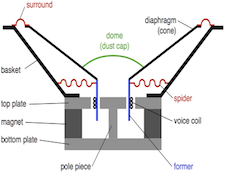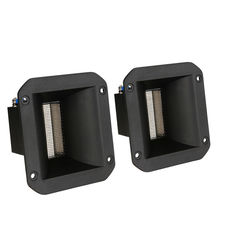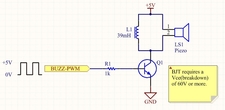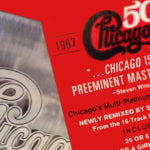It’s the time of year for saving money!
In the last installment of this continuing series on how to get the most for your hi-fi dollar, I wrote about some of the things that could go wrong when buying used “dynamic” speakers (the “regular” kind, that have direct-radiating cones and domes for drivers); how to watch out for them; and how to have (most of) those problems fixed if you have them, either with the used speakers you just bought or even with speakers that you bought a while ago, and that have failed or begun to fail since then.
 I also suggested that the better thing to do was, instead of fixing them, to try to avoid such things and, if it turns out that you can’t, to make sure that they’re somebody else’s problem by having some kind of guarantee of both current condition and minimum longevity before you ever plunk down any money. That, in itself, is one more reason to buy only from someone you know and trust or, best of all, from a local dealer, where you’ll not only get that guarantee but be able to minimize your likely need to ever call on it by auditioning the actual speakers you’re going to buy and closely examining them before you close the deal.
I also suggested that the better thing to do was, instead of fixing them, to try to avoid such things and, if it turns out that you can’t, to make sure that they’re somebody else’s problem by having some kind of guarantee of both current condition and minimum longevity before you ever plunk down any money. That, in itself, is one more reason to buy only from someone you know and trust or, best of all, from a local dealer, where you’ll not only get that guarantee but be able to minimize your likely need to ever call on it by auditioning the actual speakers you’re going to buy and closely examining them before you close the deal.
“Dynamic” speakers aren’t the only kind to be cautious of when buying speakers used. Speakers create sound by vibrating at frequencies and amplitudes controlled by their driving signal, and just as a “shaker-table” or similar device can, quite on purpose, shake an object — anything from a wristwatch to a heavy-duty truck, to a building, to the Earth, itself (remember the Tesla experiment) — to bits. So can speakers, by their own vibration, tear themselves apart, at least to the point of creating serious problems.
 I mentioned, last time, that I had had some drivers that had actually cracked their plastic “baskets”, causing the voice coils to rub in the magnetic “gap” as they tried to move back and forth to produce sound. This was certainly a rare and extreme case, but other examples of this sort of thing happening are not at all uncommon: In electrostatics and planar magnetics (Acoustat and Magnepan as an example of each), vibration can “work harden” and eventually break internal wiring and the leads of elements within the crossover. It can even shake those elements (typically resistors, coils, and capacitors) loose from their mounting points and leave them flapping free – to do anything from nothing at all to rendering the speaker totally non-functional.
I mentioned, last time, that I had had some drivers that had actually cracked their plastic “baskets”, causing the voice coils to rub in the magnetic “gap” as they tried to move back and forth to produce sound. This was certainly a rare and extreme case, but other examples of this sort of thing happening are not at all uncommon: In electrostatics and planar magnetics (Acoustat and Magnepan as an example of each), vibration can “work harden” and eventually break internal wiring and the leads of elements within the crossover. It can even shake those elements (typically resistors, coils, and capacitors) loose from their mounting points and leave them flapping free – to do anything from nothing at all to rendering the speaker totally non-functional.
Other weird things can happen specifically to electrostatic speakers: These, as many of you probably also know, are effectively just big capacitors (with the stators being “plates” of opposite charge and the charged diaphragm moving between them) As many who have tried to use them in moist climates (in Asia, for instance) have found, they can stop working just because the humidity can create an effective “short circuit” within the “capacitor” and effectively destroys – sometimes only temporarily, sometimes permanently – their “motor” mechanism. I’ve also been told of, but never personally experienced moisture-induced mold growth, either on the diaphragm or on the stator(s) creating problems for panel speakers of either electrostatic or planar magnetic design.
 Piezoelectric speakers, until recently used primarily for tweeters, but now being released for service down well into the mid-range, can also, like virtually everything else, have problems that you should watch out for. “Piezos” have been around for a good long time, and were among the first tweeters able to reach up into the range above 20kHz. This and the fact that pretty-good-sounding piezo tweeters, because they have no magnet or pole piece assembly, no voice coil, and need no high-pass crossover, can be built and used quite cheaply, made them very popular in a number of modestly-priced speaker systems that you might find on the used market. In general, piezo speakers either work perfectly or not at all, with no poor performance stage in between, and when they do fail, it’s usually either because of overheating or actual physical damage.
Piezoelectric speakers, until recently used primarily for tweeters, but now being released for service down well into the mid-range, can also, like virtually everything else, have problems that you should watch out for. “Piezos” have been around for a good long time, and were among the first tweeters able to reach up into the range above 20kHz. This and the fact that pretty-good-sounding piezo tweeters, because they have no magnet or pole piece assembly, no voice coil, and need no high-pass crossover, can be built and used quite cheaply, made them very popular in a number of modestly-priced speaker systems that you might find on the used market. In general, piezo speakers either work perfectly or not at all, with no poor performance stage in between, and when they do fail, it’s usually either because of overheating or actual physical damage.
There’s another kind of speaker, too, that works on a principle similar to that of the piezos, except that, instead of bending in response to a voltage (or producing one when bent) they change their physical dimension, getting longer or shorter in response to a driving current. The first company that I know of to offer these was Pioneer, in their HPM series tweeters and super-tweeters, and later, Anthony Gallo made tweeters of the same material special metallized polymer made by Pennwalt) in building the first Gallo speakers. These have the ability to be truly phenomenal performers, with the material, itself, having “flat” frequency response from DC into the megahertz range, limited in real-world performance only by problems of acoustical impedance in loading them to the air. The problems possible to them are, to my knowledge, virtually all mechanical, and result either from physical damage to the diaphragm material or failure or “burning-out” of their electrical connections.
 HPM tweeters are sometimes called “ribbon” tweeters, but “real” ribbons, using a magnetic drive mechanism are completely different and, again are most likely to suffer from real physical damage (stretching or tearing the ribbon, etc.) unlike the Pioneer or Gallo tweeters or conventional piezos, however, these can suffer performance degradation without failing completely.
HPM tweeters are sometimes called “ribbon” tweeters, but “real” ribbons, using a magnetic drive mechanism are completely different and, again are most likely to suffer from real physical damage (stretching or tearing the ribbon, etc.) unlike the Pioneer or Gallo tweeters or conventional piezos, however, these can suffer performance degradation without failing completely.
This issue of failure is something you really must give sertous consideration to when contemplating the purchase of any used speakers. As correspondence about the HPM super-tweeters on Audiokarma.org indicates, it’s entirely possible – even if you listen to them closely and carefully – to not be able to tell whether or not certain drivers are working. With tweeters or super-tweeters, this may be because of the limits of human hearing – especially for older males. It may also be because there’s so little information in the highest frequency range to hear. Either way, it’s entirely possible to have a dead or dying tweeter of any kind and simply not notice it. That’s also possible with any other driver, too, depending on the nature and content of the music you listen to as test material. And it’s particularly possible, with “line source” or other speakers where multiple drivers of any kind (The great bunches of tweeters, woofers, or midranges on some speakers from Infinity, McIntosh Laboratory, Mark Levinson, or Genesis Advanced Technologies, for example) are all – at least hopefully – playing at the same time. If one driver out of a whole gang of ’em isn’t working properly – or even at all – it can be hard for you to tell on just a short audition, but annoying or worse over the long run.
As I’ve said before, buying used audio gear – speakers or anything else – can be a great idea and can save you a ton of money. That’s a good thing, and the way to make sure that it stays a good thing is to be careful of what you buy; learn as much as possible about it as you can before you buy it – listening, if at all possible, before you make your final decision; deal only with people you trust (a local dealer, preferably); and get a guarantee!
I’ll be writing about something different next time. Please come see what it is.
I hope to see you then.








